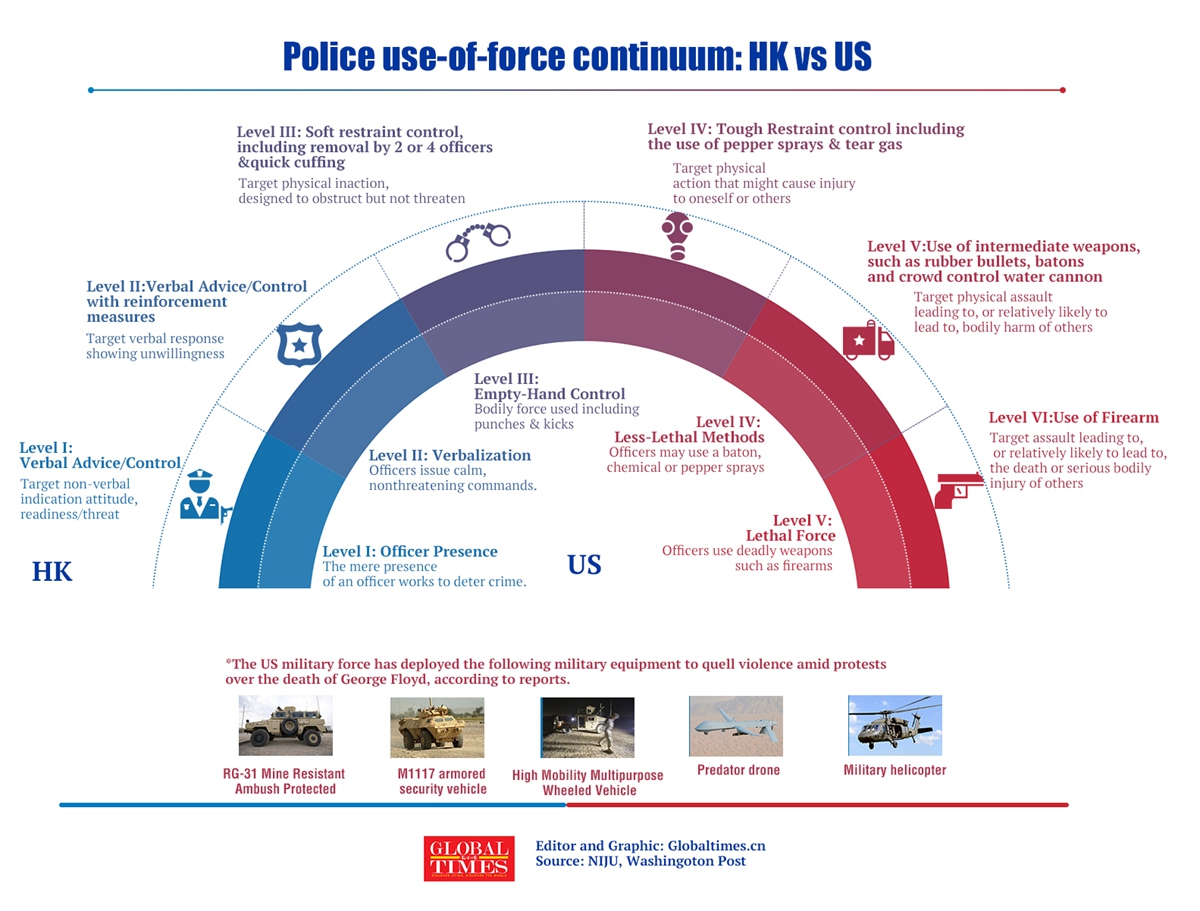Excessive VS restraint? Sharp contrast between US police and HKPF in dispersing protesters
By GT staff reporters Source:Globaltimes.cn Published: 2020/6/4 4:34:50

"Light 'em up! A police officer yelled while National Guardsmen by his side ruthlessly fired off volleys of paint at bystanders as a way to urge them to go inside. The scene happened in Minneapolis when police and the National Guard swept a local residential community to force residents to obey the curfew, according to a video taken by Russia Today on Friday.
The chilling video soon drew widespread attention and aroused heated discussion on the excessive and brutal use of force to maintain order and clear protest sites by US police and the National Guard.
Since the protests sprang up in at least 140 cities in the US following the death of African American George Floyd after being brutally treated by US police, the presence of police and National Guardsmen equipped with heavy weapons are becoming a common, yet disturbing scene on once peaceful streets. The militarization of US police has drawn attention not only in the US, but also from other countries with many people expressing concerns that this could encourage excessive force.
And many have made a comparison between the use of force by police in the US to disperse protesters and that by police in the Hong Kong Special Administrative Region (HKSAR).
While Western media outlets tried to attack Hong Kong police, calling their use of force excessive to smear their efforts in quelling violence last year, from media reports and video footage, the use of force at protest sites by Hong Kong police was much milder and more restrained than what is now happening in the US.
The US military this time has used equipment including M1117 armored security vehicles, military helicopters and RG-31 Mine Resistant Ambush Protectors.
Research into the use-of-force continuum by police reported by the media showed that the first level used by the police in the HKSAR is verbal advice or control and the second level is verbal advice or control with reinforcement measures. The third level is soft restraint control, including removal by two or four officers and quick cuffing and the fourth level is tough restraint control including the use of pepper spray and tear gas. The fifth level is the use of intermediate weapons, such as rubber bullets, batons and water cannon and the highest level is use of firearms.
In the US, the first level is officer presence and the second level is verbalization. The third level is empty-hand control while the fourth level is less-lethal methods and the highest level is lethal force.
However, in reality, the excessive use of force by US police is not unusual, especially in their treatment of black people.
Statistics showed that in 2019 alone, blacks which account for 13 percent of the US population were the victims in 31 percent of police shootings, according to online statistics portal Statista. Some 205 black people were shot by police last year. A survey done by the Washington Post after the death of Michael Brown by a white policeman in Missouri in 2014 revealed that 21 percent of the African Americans killed by police were unarmed and black people are three times more likely to be shot than white people by police. There were 1,004 police shootings in 2019, according to media reports.
However, 99 percent of police killings have not led to officers being charged with a crime or convicted between 2013 and 2019, according to a TRT World report.
This time, the protests invoked by Floyd's death to fight against police brutality and racism seem to have little impact on the excessive use of force by police, analysts said.
On Monday, Washington DC Mayor Muriel Browser decried the use of tear gas on peaceful protesters outside the White House on Monday evening, saying it's "shameful."
A reporter's observation
The Global Times reporter has witnessed protests both in Catalonia and in Hong Kong last year, and found that Hong Kong police were much more restrained compared to Spanish police, who dealt with the violence by using foam bullets, batons and armored vans to disperse violent protests.
On the night of riots on October 18, black-clad rioters wearing masks set fire at major traffic junctions in Barcelona's Plaza Catalunya, hurling Molotov cocktails toward police officers - same tactics used by radical protesters in Hong Kong. However, the way local police in Barcelona dispersed the rioters was totally different from that of the Hong Kong Police Force (HKPF).
The police on the ground, including the Spanish police and the Mossos d'Esquadra (the autonomous police force of Catalonia), remained restrained, in spite of continuous provocation from radicals. Around 10pm, dispersal began in the Catalonia Square. Several police vehicles encircled the square to disperse protesters by firing tear gas, smoke cannisters and beanbag rounds.
Unlike Hong Kong riot police, who always confront radical protesters face-to-face, police at Catalonia protests conducted dispersal from police vehicles. Though some rioters threw Molotov cocktails at the cars, police drove fast to avoid being hit.
Both Spanish police and the Mossos adopted a highly efficient way of dispersing the crowd and had done so within 30 minutes.
However, in Hong Kong, dispersal efforts usually take more than an hour as riot police have to give several warnings before taking action. Also, some "journalists" in their yellow vests, always stand between police and protesters in Hong Kong and sometimes obstruct police using their bodies and cameras.
Fewer reporters in the Catalonia protests got the chance to stand in front of police during law enforcement as police officers usually disperse reporters first.
Also, in Catalonia, when the dispersal started, they always stood behind the police, as blocking police law enforcement would mean jail time.
Posted in: AMERICAS,HK/MACAO/TAIWAN,FOCUS1